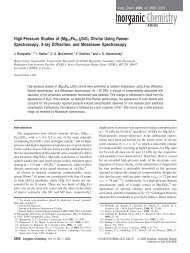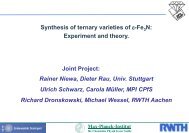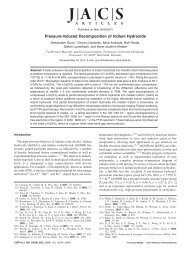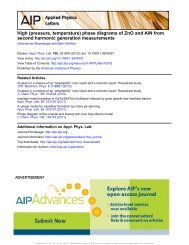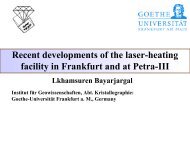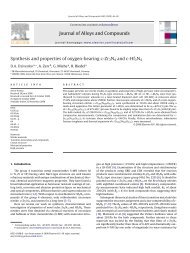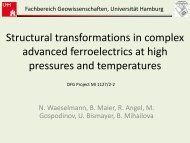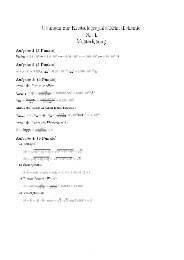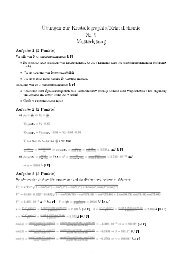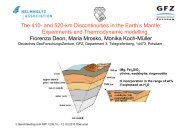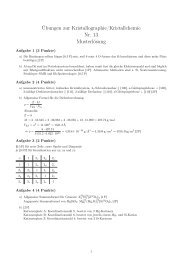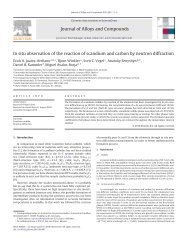Raman spectroscopic study of PbCO3 at high pressures and ...
Raman spectroscopic study of PbCO3 at high pressures and ...
Raman spectroscopic study of PbCO3 at high pressures and ...
You also want an ePaper? Increase the reach of your titles
YUMPU automatically turns print PDFs into web optimized ePapers that Google loves.
Fig. 5 Temper<strong>at</strong>ure<br />
dependence <strong>of</strong> the internal<br />
<strong>Raman</strong> mode frequencies <strong>at</strong><br />
7.6(2) GPa: a v 2-out-<strong>of</strong>-plane<br />
b<strong>and</strong> (filled triangle), b v 1asymmetric<br />
stretching vibr<strong>at</strong>ion<br />
(open circle), cv 4-out-<strong>of</strong>-plane<br />
b<strong>and</strong> [1 B 3g (filled right<br />
triangle), 2 A 1g (filled circle),<br />
3 B 2g (filled square), 4 B 1g<br />
(open circle)]. The size <strong>of</strong> the<br />
symbol corresponds to the<br />
errors in <strong>Raman</strong> shift <strong>and</strong> T in<br />
c <strong>and</strong> in T in a, b<br />
The behavior <strong>of</strong> almost all the b<strong>and</strong>s is similar in the case <strong>of</strong><br />
the experiment performed <strong>at</strong> 17.2(2) GPa <strong>and</strong> temper<strong>at</strong>ures<br />
up to 544 K (Fig. 8). Increasing temper<strong>at</strong>ure virtually leaves<br />
the position <strong>of</strong> the b<strong>and</strong>s unaffected, displacements being less<br />
than 1 cm -1 (Fig. 9), <strong>and</strong> the number <strong>of</strong> b<strong>and</strong>s unchanged.<br />
Thus, we conclude th<strong>at</strong> the phase III has already been formed.<br />
Its form<strong>at</strong>ion was accompanied by the occurrence <strong>of</strong> three<br />
new b<strong>and</strong>s (v2 0 , 7, 8) <strong>at</strong> different <strong>pressures</strong> <strong>and</strong> splitting <strong>of</strong> the<br />
v1-symmetric C–O stretching mode <strong>of</strong> the CO3 2- group<br />
(Fig. 8). Direct qualit<strong>at</strong>ive comparison <strong>of</strong> the spectra obtained<br />
<strong>at</strong> room temper<strong>at</strong>ure <strong>and</strong> 17.2(2) GPa (Fig. 8) <strong>and</strong><br />
15.6(2) GPa <strong>and</strong> 323(3) K (Fig. 6), respectively, shows the<br />
same pr<strong>of</strong>ile <strong>and</strong> number <strong>of</strong> b<strong>and</strong>s. This implies th<strong>at</strong> <strong>PbCO3</strong><br />
has the same structure under both conditions. The frequencies<br />
<strong>of</strong> all modes change monotonously with increasing temper<strong>at</strong>ure<br />
(Fig. 9). A change <strong>of</strong> the slope <strong>of</strong> the temper<strong>at</strong>ure<br />
dependence <strong>of</strong> the v 4 internal vibr<strong>at</strong>ions (Fig. 9a) was<br />
observed in the 330(3)–350(3) K temper<strong>at</strong>ure range.<br />
Isothermal (544(3) K) decompression<br />
(a)<br />
Isothermal decompression was carried out in the last set <strong>of</strong><br />
experiments. The pressure was released with 1 GPa steps <strong>at</strong><br />
123<br />
(c)<br />
(b)<br />
Phys Chem Minerals<br />
a constant temper<strong>at</strong>ure <strong>of</strong> 544(3) K. The two additional<br />
b<strong>and</strong>s (marked 7 <strong>and</strong> 8 in Fig. 10), which had appeared<br />
during compression <strong>at</strong> 17.2(2) GPa (Fig. 8b), disappear<br />
below 12.2(2) GPa, as shown in Fig. 10. The disappearance<br />
upon decompression <strong>and</strong> appearance upon compression<br />
(Figs. 1, 2d) <strong>of</strong> the v2 0 out-<strong>of</strong>-plane b<strong>and</strong> takes place <strong>at</strong><br />
about 10 GPa. The v1 0 b<strong>and</strong> disappears just below<br />
12.2(2) GPa upon isothermal decompression <strong>at</strong> 544(3) K<br />
(Fig. 10b). Figure 11 shows the <strong>Raman</strong> b<strong>and</strong>s <strong>of</strong> <strong>PbCO3</strong> <strong>at</strong><br />
544(3) K as a function <strong>of</strong> pressure. The mode shifts <strong>of</strong> the<br />
b<strong>and</strong>s 7, 8 <strong>and</strong> v 4-B 1g are not shown. B<strong>and</strong>s 7 <strong>and</strong> 8 are<br />
virtually pressure-independent. v4-B1g is very weak, in fact<br />
hardly distinguishable from the noise. It is therefore difficult<br />
to determine its precise position. The dv/dP values<br />
are given in Table 3. Mode s<strong>of</strong>tening <strong>of</strong> v2 <strong>and</strong> v2 0<br />
was observed in the whole pressure range (Fig. 11b, d).<br />
The slope dv 2/dP changes <strong>at</strong> <strong>pressures</strong> <strong>of</strong> about 13.0(2)<br />
<strong>and</strong> 7.2(2) GPa. The second change <strong>of</strong> the slope suggests<br />
the return to the orthorhombic starting phase. The same<br />
behavior is observed for v 4 b<strong>and</strong>s marked 1, 2, 3 in<br />
Fig. 11a, namely the same stable value <strong>of</strong> dv/dP in the<br />
15.0–13.0 GPa pressure range <strong>and</strong> change <strong>of</strong> the slope <strong>at</strong><br />
about 13.0(2) <strong>and</strong> 7.2–7.8 GPa. The disappearance <strong>of</strong> the



